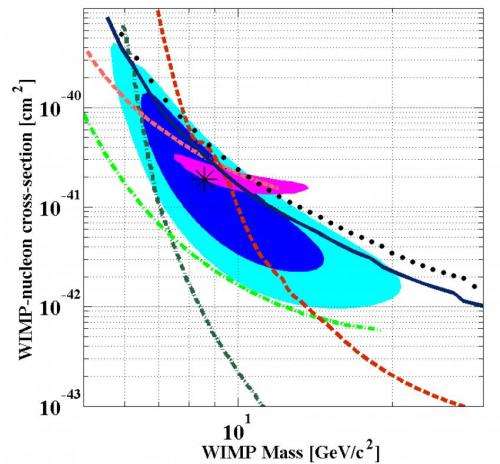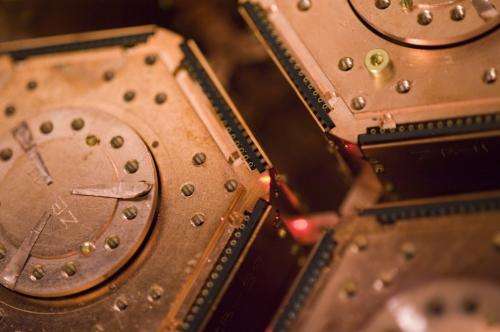April 16, 2013 report
Super-CDMS researchers report possible evidence of WIMPs

(Phys.org) —Researchers working at the Super Cryogenic Dark Matter Search (CDMS) facility, located underground in Minnesota's Soudan Mine, are reporting in a paper uploaded to the preprint server arXiv that they've found three events that lie in the signal range of Weakly Interacting Massive Particles (WIMPs). The group also gave a talk detailing their results to an audience at this year's American Physical Society meeting—as part of that discussion, they made it clear the noted events do not rise to the level of discovery, nor do they imply the team has found evidence of the existence of dark matter.
Researchers in several facilities around the world (and aboard the International Space Station) are looking for evidence of WIMPs, because theory suggests that they constitute dark matter, the invisible material believed to make up approximately 85 percent of all matter that exists in the universe. Because WIMPs can't be seen directly, researchers look to events that might prove they exist, such as collisions between WIMPs and atomic nuclei. In order to find such evidence, researchers set up detectors they hope will catch such collisions that occur due to gravitational pull on WIMPs—they are believed to interact only rarely with normal matter through other means.

Researchers at the Super-CDMS facility have set up eight silicon detectors (cooled to -459.67 degrees Fahrenheit) in the hope of detecting the slight amount of heat given off by a collision between a WIMP and an atom's nucleus. The researchers report detection of three events that might have been the result of such collisions, though they are quick to add that the events might also have been due to something else, such as statistical errors. However, calculations indicate the events are 99.81 percent more likely to be WIMPs than background fluctuations, which translates to approximately a three-sigma level of confidence.
Interestingly, if the detected events do turn out to be the result of WIMP/nucleus collisions, it will mean that WIMPs are much lighter than scientists have been expecting—the detected collisions detected to just 8.6 giga-electronvolts. The researchers note this finding is in line with results from other research efforts, though they also acknowledge that it contradicts the findings of other researchers. Regardless, research at the Super-CDMS facility and elsewhere will continue until WIMP collisions are proven to exist, or not.
More information:
Dark Matter Search Results Using the Silicon Detectors of CDMS II. arXiv astro-ph.CO, (2013)
Silicon Detector Results from the First Five-Tower Run of CDMS II. arXiv astro-ph.CO, (2013), arXiv:1304.3706
E. Figueroa-Feliciano's presentation at Light Dark Matter 2013.
Journal information: arXiv
© 2013 Phys.org



















